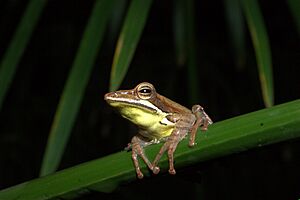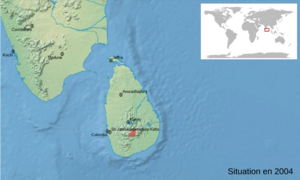Taruga eques facts for kids
Quick facts for kids Taruga eques |
|
|---|---|
 |
|
| Conservation status | |
| Scientific classification | |
 |
|
| Synonyms | |
|
Polypedates eques Günther, 1858 |
Taruga eques is a special kind of frog that lives only in the central mountains of Sri Lanka. It's sometimes called the Günther's whipping frog or the montane hour-glass tree-frog. This frog is part of the Rhacophoridae family, which includes many tree frogs. It's an endemic species, meaning you won't find it naturally anywhere else in the world!
Contents
What Does the Taruga eques Look Like?
These frogs come in different sizes. Adult male frogs are about 33–43 mm (1.3–1.7 in) long from their nose to their rear end. Female frogs are larger, measuring about 59–71 mm (2.3–2.8 in).
This frog looks a lot like another frog called Taruga fastigo. But there are a few ways to tell them apart. The Taruga eques has shorter legs and a narrower but longer head. It also doesn't have a black line connecting its armpit to its groin, or if it does, it's just a few black dots.
A unique feature of the Taruga eques is a small bump or "spur" on its heel. This "calcar" helps scientists tell it apart from other frogs in the same group.
Where Does the Taruga eques Live?
Frog Homes in the Mountains
The Taruga eques lives in wet, tropical forests high up in the mountains. You can find them at elevations from 1,200–2,135 m (3,937–7,005 ft) above sea level. These frogs spend their time both in trees and on the ground.
You might spot them in the leafy tops of trees or on tree trunks. They also like to hang out in the grass near the edges of ponds.
Tadpoles and Their Ponds
The baby frogs, called tadpoles, live in ponds. They can be found in ponds that stay full of water all year round, as well as in ponds that dry up during certain seasons. These frogs need their natural forest homes and don't usually live in areas changed by people.
Protecting These Special Frogs
Even though the Taruga eques is a common frog, its home is shrinking. Forests are being cut down for farms, logging, and building roads. Forest fires also destroy their habitat. These changes make it harder for the frogs to survive.
Good news! This frog lives in some protected areas in Sri Lanka. These include the Horton Plains National Park, the Hakgala Strict Nature Reserve, and the Peak Wilderness Sanctuary. These places help keep their mountain forest homes safe.
What is Polymorphism?
Polymorphism is a cool science word. It means when a species has two or more different forms or appearances living in the same place at the same time. These different forms are common enough that they aren't just rare mistakes. For example, some Taruga eques frogs might have different skin patterns or colors, even if they are from the same family.
Gallery







